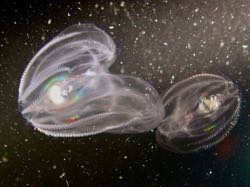Sea Walnut
Scientific Name
Mnemiopsis leidyi
Distribution & Habitat
The sea walnut or comb jelly is very common throughout most of Chesapeake Bay, and, while the population spikes seasonally, is present year-round.
Sting
Ctenophores like the sea walnut do not sting. Instead, their tentacles possess special adhesive cells called colloblasts that release a sticky, mucus-like substance to trap prey.
Size & Shape
As the common name suggests, sea walnuts are shaped like the meat of a walnut. As adults, they lack tentacles and can grow to several inches in length. Also known as a comb jelly, because they have rows of cilia that look like the teeth of a comb. These cilia easily refract light and cause pulsing rainbows to travel along their body.
Color
Sea walnuts are transparent or white. They can produce light when agitated, and can often be seen flashing brightly in boat wakes at night.


